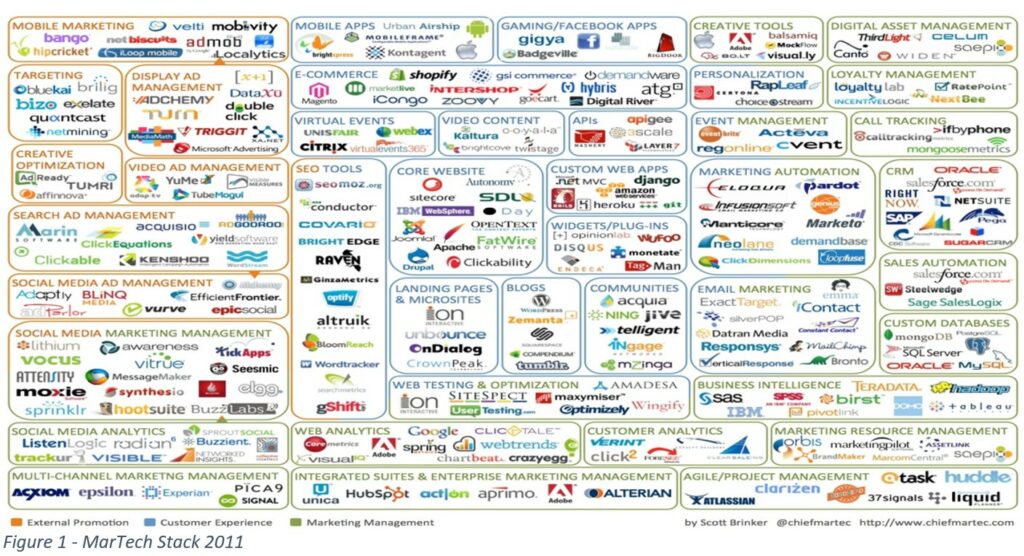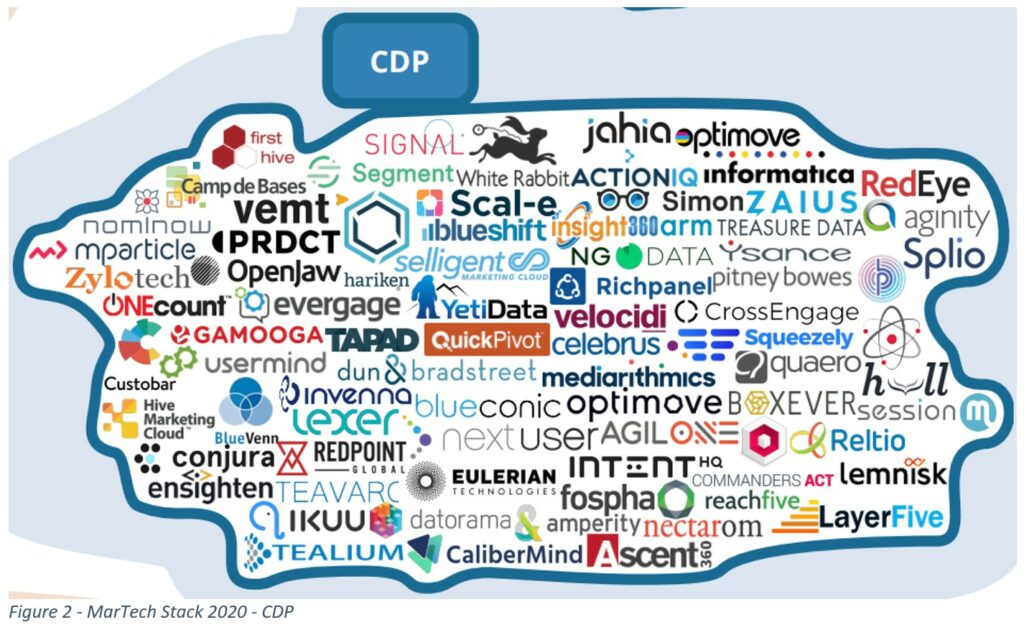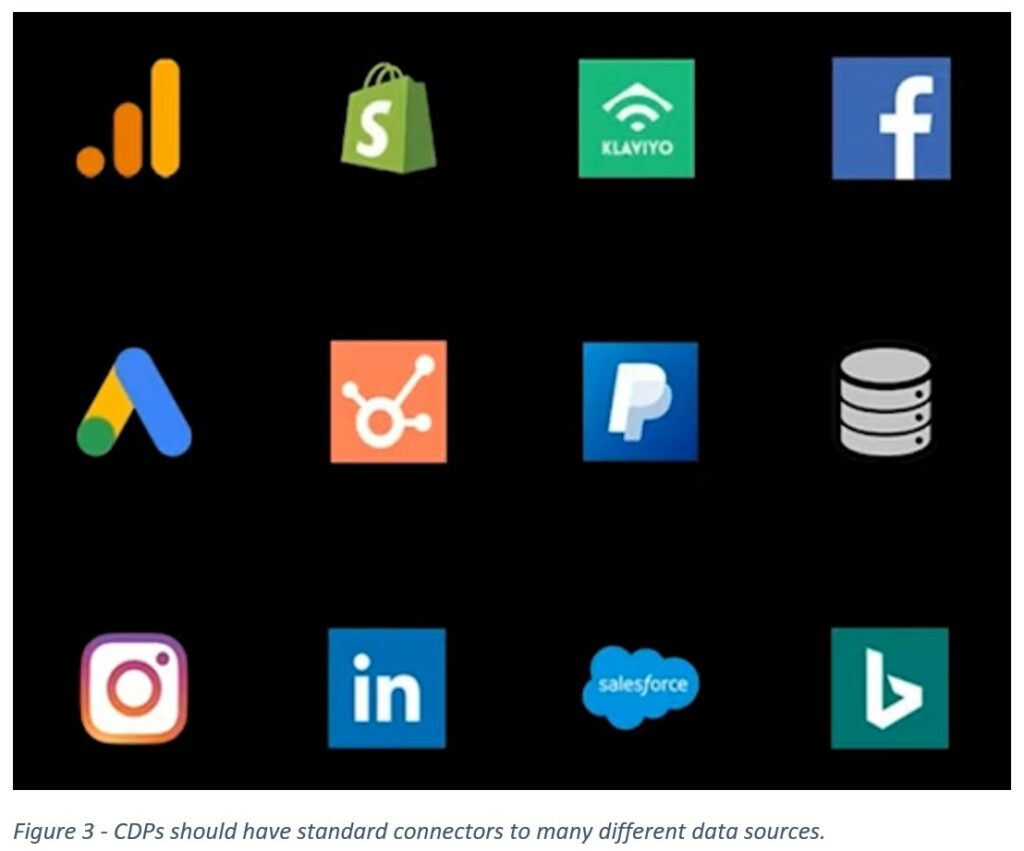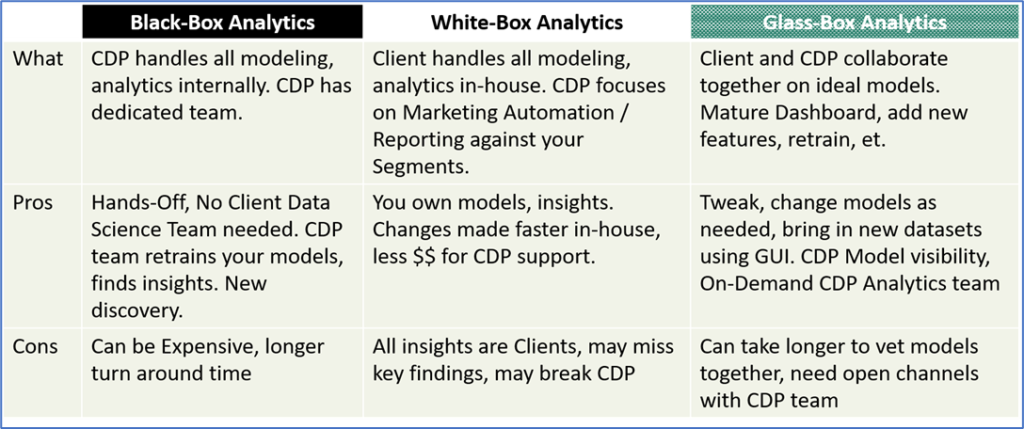The best advertising should make you nervous about what you’re not buying.
Mary Wells Lawrence
Founder, President — Wells, Rich Green
Just what is a Customer Data Platform?
So you’re evaluating CDPs and need to know what to look for? You’ve come to the right place! A Customer Data Platform can help you better understand your customers and what drives them to engage with your brand or product. In this post we’ll cover what a Customer Data Platform is and how they can help you achieve your Marketing goals. We’ll also mention some issues to watch out for, as not all CDPs are created alike.
There are numerous definitions out there for CDPs but here are the two that I like the best:
A Customer Data Platform is packaged software that creates a persistent, unified customer database that is accessible to other systems.
A Customer Data Platform is used to Aggregate, Segment, and Augment 1st-party Customer Data in order to better drive Conversions using more targeted Marketing Campaigns.
I know what you’re thinking: “Hey, I already have a database and when I checked this morning, it had my customer data in it. So that is a CDP, right?”
Not exactly. A CDP is not just a repository of 1st party customer data. It’s a collection of data and services that unify your customer data and give you insights into how your customers engage with your company. You can then turn around and use these insights to better market to them, thereby helping to hit your goals for conversion, upsell, retention, or brand awareness.
For instance, you may have an account table listing all of your customers, as well as a table containing sales orders. This is a good start, but there are other things going on that your solution might be missing:
• How about your customers’ web activity and the fact that customer #124 had two abandon cart episodes last week?
• What about customer #467, who has been one of your most valuable customers over time, and has not had any contact with the company in months?
• Did you know that the behavior of ten customers in the last few days would put them in the “Ready to Churn” segment, had your database had proper segmentation and been tracking such activities?
Yes, you may have web behavior, newsletter signups, and mobile app information for your customers as well, but is it all in one place? Is the schema and table layout easy to understand and ready to be leveraged into actionable insights? And what about the feedback loop? How are customer reactions to your various marketing activities recorded and made available for reporting? Modern Customer Data Platforms answer these questions, allowing you to act on different customer responses and learn how customers engage with your brand. A CDP will organize your customer data in a way that is easy for Marketers to understand via a carefully tuned data schema built for analytics.
These are just a few of the capabilities a modern CDP can provide.
A Brief History of the CDP
Did you know there is actually an Institute for Customer Data Platforms? Their website has a page on what a CDP is and why Customer Data is essential to controlling the CX or Customer Experience today. It also seems to be a catchall for CDP vendors to convince you that their product is the best. The Blog section has some good articles, mostly written by CDP vendors themselves. However, many links require you to supply your contact information, at which point you’ll likely be inundated with mail from the many CDPs the Institute represents. I resisted and my inbox is still (relatively) clean. 🙂
In the beginning, there were only a few players in MarTech (Marketing Technology) space and no real Customer Data Platforms. This awesome graphic is from chiefmartech.com’s Scott Brinker in 2011. Notice how these were pretty much ALL the players in the MarTech space in 2011:

It’s hard to see, but there are few big names here, such as Adobe, Salesforce, Oracle, SAS, IBM, Tableau, et. But there are many more companies that have disappeared from the landscape and the term Customer Data Platform doesn’t appear at all.
According to the Institute, the term “Customer Data Platform” first gained traction back in 2013 and was borne out to the fact that most data systems were not designed to play nice with others. The Point-of-Sale database had some customer information, the web team that managed the Contact Form had some data, and the Email Marketing team was working hard to keep its spreadsheets updated.
No one had a clear picture of all customer engagement and stitching together all the sources was time consuming and error prone. What’s more, the resulting data warehouse that held all the data couldn’t do things like find new customer segments, inform you of patterns of behavior, or activate your customers via a specific marketing campaign.
While reporting tools like Tableau, PowerBI, Looker, and others have tried to bridge the gap between disparate tables and data sources, such a solution locks you into that tool and marketers needed flexibility. Also, they were yearning for a solution that didn’t require five data engineers, two data scientists, and the entire IT department to get up and running.
Thus, the Customer Data Platform was born. The cheap storage and compute that major cloud players, such as Amazon’s AWS and Microsoft Azure, provide made it a no-brainer for modern CDPs to become PaaS (Platform as a Service) products and be completely cloud-based.
Today, there are many companies in the CDP space and the number keeps growing every year. Here’s Scott Brinker’s MarTech Stack 2020, zoomed into just the Customer Data Platform section:

There is no point in showing you the entire graphic since it won’t fit well in this post. The “MarTech” space has grown to over 8,000 companies! You can see the entire 2020 MarTech Landscape here.
EDW, CRM, DMP, DSP, CDP… SOS!
There are all sorts of tools (and acronyms) out there today that can automate your marketing strategy, better understand your customer, increase sales, or just store data. Let’s review some tools that often get confused with a Customer Data Platform:

While a CDP can have some features of the tools above, its main focus is on the analysis of customer attributes and behavior, as well as customer segmentation and activation. CDPs are designed to interface with these other systems and, in some cases, have additional features such as ID resolution.
Key Features of a Modern CDP
Customer Data Platforms should be good at most things involved with understanding your customer and how they engage with you. In order to do that, there are some key features to look for in a CDP. Failing on any of the below traits, such as the inability to source customer data or an inflexible data model, can leave you trying to understand the CDP, rather than trying to understand your customer.
Seamlessly Source 1st-Party Data from CRM, EDW
Remember, it’s a Customer Data Platform after all. CDPs need to be able to ingest your 1st-party customer data from all sorts of different types of datastores. The easier the data can be landed and normalized in the CDP, the easier it will be for you to start learning about your customers and targeting different audiences.
Most 1st-party data, that is your known customers, resides with you somewhere in a database or enterprise data warehouse. The technology may be SQL Server, AWS Redshift, Oracle, MySQL, Azure SQL Database, Snowflake, or a host of others. The chances are good that it is a relational database and accepts ODBC / JDBC connections. Your CDP should be able to connect to it and pull data down on a schedule that you define once you set the connection properties.
Some of your customer data may NOT in a relational database; however, and then things get trickier. For instance, some CDPs can incorporate 3rd-party data, which are not mapped to a specific customer yet but have the potential to be. This data can be from services like Google Analytics, DoubleClick, Freewheel, and other beaconing platforms. Data from these services are usually delivered via REST APIs which require their own separate “connectors”. A good CDP will have standard connectors to these types of services.

If there is a data source for which there is not a connector, you’ll have two options: 1) have the CDP on-board your data (usually for a fee) or 2) write your own data transfer process to land your data into a data store that the CDP can then ingest from. Option 1 is usually a non-starter unless this is a one-time historical movement of data.
A few CDPs will allow you to develop these connections on their platform using scripting languages such as Python. The main takeaway here is that the CDP should have as many ways to ingest your data into the platform as possible. JDBC / ODBC, Standard connectors to a variety of common data sources, FTP delivery, dealing with compressed data, scheduling – look for these features and how easy they are to use in your CDP.

What about data behind a firewall?
Most on-premise data is behind a firewall of some sort, which is a program that only lets traffic in and out via specific ports or from specific IP ranges. The CDP should have information on which ports it uses when requesting data and from what IP ranges those requests originates. Give this information to your network administrator so an exception can be created in your firewall so that the data can reach the CDP.
What about encryption?
1st-party customer data is PII (Personally Identifiable Information) in the purest form. Perhaps you’re not storing customer credit cards or social security numbers, but there are plenty of ways to identify your customers: first / last name, address, email, phone numbers, et. The CDPs I mention here (almost all CDPs these days) are cloud-based, which means your valuable customer data will be traveling from your hopefully secure CRM or EDW and out over the world wide web to this service hosted who knows where.
This encryption should be handled both during “in-transit” and “at-rest”, which means that whenever the data is moving to the CDP or stored in the CDP, it is encrypted and never available in plain text. Good CDPs will handle this transparently for you, keeping your data separate from other clients, and have a proper key rotation strategy in place. Keys are used to help encrypt and decrypt your data, so they need to change occasionally lest a key fall into the wrong hands!
Finally, and this should be obvious, all communication with the CDP should be done over HTTPS – Hypertext Transfer Protocol Secure. Each CDP vendor should have their own standards for security and they all will vary slightly, but these are the core tenets.
Customer Data Model
Customer Data Platforms should have a standard schema or layout for what it defines as a Customer and provide an easy way to map fields from different data sources into this schema. For instance, if I have a CRM system, and database containing email records, and a Sales database, I should be able to map different fields from these sources to my customer model in the CDP. This mapping should be setup at the beginning and any new data brought in should be mapped to the customer model on an ongoing basis.
Also, certain groupings and aggregations, such as Last Purchase Date or Total Session Count should be able to be done in the CDP. If you must prepare these aggregations outside your CDP and then import them, your CDP is not doing enough of the heavy lifting.
For example, here is a simple example of how source data systems could map to the CDP customer model:

As you can see, it is usual for different data sources to make up the whole customer picture. To properly segment and analyze customer behavior, we might need Sales History, Web Site Visits / Clicks, Consent data, Total Lifetime Spent, Advertising engagement and more. The CDP you choose should have an easy way of ingesting this data and mapping it to appropriate fields in the CDP’s Customer Model. Creating and mapping new attributes in the Customer Model should be easy as well.
NOTE: MOST RECENT(ProductID) is there to illustrate a desired field outcome. It is not valid SQL.
Segmentation
An efficient way to direct advertising and personalization is by targeting groups of people with similar attributes in specific ways. Customer Segmentation makes this possible and it should be a core feature of any CDP. It means creating segments that make sense for your business and putting customers in those segments that are similar in terms of behavior, spending habits, sales lifecycle, or other attributes. The Segmentation feature in the CDP should be easy to setup and the segments themselves easy to define. You should also be able to setup alerts and notifications for when customers move from one segment to the next or when a key customer attribute that you are interested in changes.
For example, say I would like the following Segments defined:
1. Newly Engaged – first order, first cart abandonment, first newsletter subscribe.
2. Ready To Churn – medium / high value customers, no contact in three months or unresolved customer service ticket.
3. High Value – high customer lifetime value, multiple purchases, recent purchases, social influencer.
4. Newsletter Subscribers – otherwise unengaged.

In each of these segments there is an opportunity to either make money or save money. Segments give you the ability to see which of your customers are the most valuable, who could be made more valuable, and those who are a lost cause that you should not waste any more marketing dollars on.
A quality CDP should keep you abreast of changes to your segments, who’s moving in, who’s moving out, and will also alert you to certain conditions, such as when a High Value customer leaves the segment! This allows you to take action, perhaps with a coupon, promotional gift, or just a friendly email to reestablish that connection.
One can have many more Segments than this of course, and some CDPs will have different ways of analyzing customer attributes and how it places customers in your segments. This should be a process that you, the owner of your customer data and potentially the best “subject matter expert” on your business domain, can control and guide.
Segment Activation
Once our segments are defined and populated, the next step is to drive different marketing campaigns towards them. This can be an email campaign, a digital ad campaign, social outreach, or some combination. For the best results, these campaigns should be carefully tuned to the segment you are targeting. Depending upon the channel, your customers reactions to these marketing events can then be tagged back to them, creating this 360-degree view of how your customers engage with your business.

CDP Analytics: Three Types
Remember, when it comes to customer analytics, you understand your customers and your business domain much better than the CDP. Some CDPs employ several different modeling techniques to recommend new segments, calculate lifetime value, and even predict a “next best action” based on different inputs. Depending upon how technical you and your team are, you may want to control this process at different levels to tweak the results for your business.
For instance, you know for a fact that customers without engagement in the last six months should not be included in Segmentation. You also know that a lot of cart abandonment issues are due to the fact that the website session times out after 5 minutes, frustrating shoppers who are not finished yet. If you cannot easily convey these facts to the CDP than you may be wasting marketing dollars on customers who may not respond at all or grouping customers in the wrong segments altogether.
Generally, analytics and modeling in Customer Data Platforms take three forms:

Which type works for you and your marketing team will depend on how technical you are and how much handholding you require.
In the “Black-Box Analytics” world, the CDP comes with a readymade team of analysts, engineers, and data scientists to help you get the most out of the platform. This might seem great at first, but this team can be an expensive add-on and be repurposed by the CDP company at any time, making commitments difficult. Furthermore, because they don’t know your specific company, results can take longer as you teach them the nuances of the standup paddle board business (or whatever your product / service is). It can work, though, in certain situations where you and your team do not have the skills or time to do the initial setup. Just make sure that, at some point, there is a hand off, where you and your team can manage the platform and analytics yourself.
“White-Box Analytics” is where you are left to supply the CDP with different customer segments that you build yourself. Here you would pre-label your customers based on your own research and simply bring those labeled customers into the CDP preassigned. This works if you already have a rock-solid process for customer segmentation and you just need the CDP for marketing automation and reporting purposes. This makes the CDP cheaper to implement as you are not relying on it for modeling.
“Glass-Box Analytics” is what most CDPs are striving for today. The CDP (and perhaps the services team) shows you ideal groupings of customers based on your input data and the ideal way to create segments that drive towards your stated goal (increased revenue, conversions, brand awareness, et). The difference is that the platform is transparent in how your segments are defined, has easy controls to filter, add / remove fields, and allows you to rebuild the entire segmentation model yourself if needed. The hand holding is there, especially in reporting, but you can take control at any time and customize the CDP to your business.
In a perfect world, the CDP will be easy to setup for modeling and segmentation yet transparent in how it is coming up with results and customizable to your business needs. Watch out for expensive after purchase service plans. These are usually an indication that the CDP doesn’t have all the controls it needs to import difficult data streams, alter how segments are designed, or easily setup dashboards.
Standard vs Enterprise CDPs
The CDP you choose should have multiple options for Segment Activation and be able to handle this process in-platform or via special “activation connectors” that interface with different Marketing Automation tools. Many CDPs today have a limited set of tools when it comes to Marketing Automation, requiring you to sign up for more products to get the message out to your customers.
Enterprise CDPs are Customer Data Platforms that have broad features that enable Marketing Automation and enrich your customer data. Enterprise CDPs:
• Can link in with a native CRM as the SOT (Source of Truth). Customer data can flow back and forth across the CDP and CRM boundary easily.
• Have a consistent process for tying marketing events back to the customer.
• Are able to string together decision points and build out customer marketing journeys. If user clicks link in email AND adds product to cart, THEN do this.
• Have native connections to tools such as an Email Marketing service and Digital Advertising service to drive ads across search, display, and social at scale.
• Can easily incorporate 3rd-party data with a robust ID Resolution process to map obscure digital events to known customers.
Note that in many smaller CDPs, how a customer responds to your campaign may NOT be automatically tagged back to the customer. Another tool or an ETL process that your team builds would have to poll, say the Google Analytics API, to find out which of your customers in Segment A generically (without help) visited your website last week. Enterprise CDPs have more tools and features baked in to do this sort of work for you.
eSage Group: Your CDP Partner
At eSage Group, we’ve been building Customer Data Platforms long before they got popular. The notion of creating “one view” or a “360 degree view” of the Customer is really about one thing: bringing together disparate datasets containing customer data via a resilient, fault-tolerant ETL process and normalizing this data into business data marts that allow you to easily create actionable insights. We are specialists in customer segmentation, marketing analytics, and audience activation. However, these activities, much like the benefits of a CDP, cannot be realized without clean, reliable customer data.
So if there is a CDP that you are considering, already have a CDP that needs tuning, or need to bring in a new data sourcejust have questions about where to go next, eSage Group can help. We have extensive experience with both Microsoft / Azure and AWS technologies and services and are also a Certified Salesforce Partner.
Conclusion
In many respects, your choice of CDP technology will influence your marketing strategy. A decision that used to be driven by IT (purchase / install software) is now being handled by Marketing, because of its need to better understand the customer and react faster to customer decisions. The Customer Data Platform “software” is now hosted in the cloud, so there is nothing to install. Be sure to research how your potential CDP handles encryption and what it does to get data out behind a firewall.
The biggest hurdle is giving your new CDP the data it needs, and then instructing it on how to deliver the insights that you need. The CDP should have plenty of standard connectors to data sources such as relational databases, web services, and platforms such as Facebook, Google Analytics, Segment, Zendesk, and many others. It should also have an easy to follow process for ingesting custom datasets, such as compressed data living in AWS S3.
CDPs should be good at Customer Segmentation and allow you to control how your customer data is modeled. Segment membership and movement should be transparent and alert-able from the platform. Also, watch out for “Black-box Analytics” platforms that don’t shed light on how your customer data is being used as you may be going back to the CDP’s “professional services” team time and time again.
CDPs generally come in two sizes: Standard or Enterprise. The Enterprise CDP will usually have much better integration with Marketing Automation tools, allow you to activate your customer segments easily and increase engagement. Smaller CDPs will usually require help to update customer data after a marketing event has taken place and come with fewer integration points with automation tools.
Best of luck in your CDP search or implementation! Again, if you need a hand or would like to chat about options, eSage Group can help.
About eSage Group
eSage Group provides best practice offerings in Data Strategy, Data Engineering, Visualization and Data Science to augment internal teams and help you move quickly toward an optimal marketing analytics platform with effective customer acquisition, retention, and engagement.
With certified specialists across a range of technologies, including Salesforce, Snowflake, AWS, and Azure, plus 20 years of experience extracting value from customer data, eSage Group will help you efficiently integrate any data source and amplify the value of data across your organization.
Ready to learn more? Contact eSage Group today!

